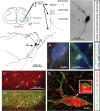The continuing case for the Renshaw cell
- PMID: 17640932
- PMCID: PMC2277064
- DOI: 10.1113/jphysiol.2007.136200
The continuing case for the Renshaw cell
Abstract
Renshaw cell properties have been studied extensively for over 50 years, making them a uniquely well-defined class of spinal interneuron. Recent work has revealed novel ways to identify Renshaw cells in situ and this in turn has promoted a range of studies that have determined their ontogeny and organization of synaptic inputs in unprecedented detail. In this review we illustrate how mature Renshaw cell properties and connectivity arise through a combination of activity-dependent and genetically specified mechanisms. These new insights should aid the development of experimental strategies to manipulate Renshaw cells in spinal circuits and clarify their role in modulating motor output.
Figures





Similar articles
-
Role of primary afferents in the developmental regulation of motor axon synapse numbers on Renshaw cells.J Comp Neurol. 2016 Jun 15;524(9):1892-919. doi: 10.1002/cne.23946. Epub 2016 Jan 4. J Comp Neurol. 2016. PMID: 26660356 Free PMC article.
-
Primary afferent synapses on developing and adult Renshaw cells.J Neurosci. 2006 Dec 20;26(51):13297-310. doi: 10.1523/jneurosci.2945-06.2006. J Neurosci. 2006. PMID: 17182780 Free PMC article.
-
Pax6 and engrailed 1 regulate two distinct aspects of renshaw cell development.J Neurosci. 2004 Feb 4;24(5):1255-64. doi: 10.1523/JNEUROSCI.3187-03.2004. J Neurosci. 2004. PMID: 14762144 Free PMC article.
-
Principles of interneuron development learned from Renshaw cells and the motoneuron recurrent inhibitory circuit.Ann N Y Acad Sci. 2013 Mar;1279:22-31. doi: 10.1111/nyas.12084. Ann N Y Acad Sci. 2013. PMID: 23530999 Free PMC article. Review.
-
GABAergic inhibition in the neostriatum.Prog Brain Res. 2007;160:91-110. doi: 10.1016/S0079-6123(06)60006-X. Prog Brain Res. 2007. PMID: 17499110 Review.
Cited by
-
The Cell Autonomous and Non-Cell Autonomous Aspects of Neuronal Vulnerability and Resilience in Amyotrophic Lateral Sclerosis.Biology (Basel). 2022 Aug 8;11(8):1191. doi: 10.3390/biology11081191. Biology (Basel). 2022. PMID: 36009818 Free PMC article. Review.
-
Mafa-dependent GABAergic activity promotes mouse neonatal apneas.Nat Commun. 2022 Jun 7;13(1):3284. doi: 10.1038/s41467-022-30825-3. Nat Commun. 2022. PMID: 35672398 Free PMC article.
-
Modulation of motoneuron firing by recurrent inhibition in the adult rat in vivo.J Neurophysiol. 2014 Nov 1;112(9):2302-15. doi: 10.1152/jn.00358.2014. Epub 2014 Aug 13. J Neurophysiol. 2014. PMID: 25122713 Free PMC article.
-
Acetylcholine and spinal locomotor networks: The insider.Physiol Rep. 2021 Feb;9(3):e14736. doi: 10.14814/phy2.14736. Physiol Rep. 2021. PMID: 33527727 Free PMC article. Review.
-
Spinal V1 inhibitory interneuron clades differ in birthdate, projections to motoneurons, and heterogeneity.Elife. 2024 Nov 28;13:RP95172. doi: 10.7554/eLife.95172. Elife. 2024. PMID: 39607843 Free PMC article.
References
-
- Alvarez FJ, Dewey DE, Harrington DA, Fyffe RE. Cell-type specific organization of glycine receptor clusters in the mammalian spinal cord. J Comp Neurol. 1997;379:150–170. - PubMed
-
- Alvarez FJ, Gonzalez-Forero D. Maturation of GABAA synapses on Renshaw cells. Abstr Soc Neurosci. 2006:716–717.
Publication types
MeSH terms
Substances
Grants and funding
LinkOut - more resources
Full Text Sources

